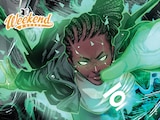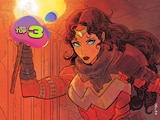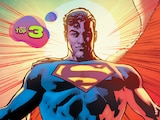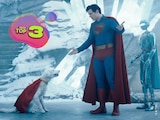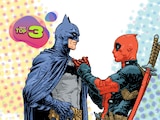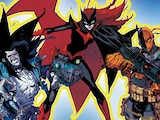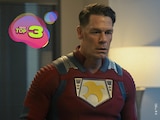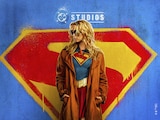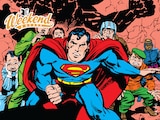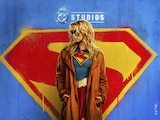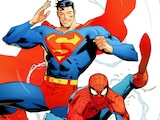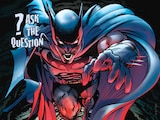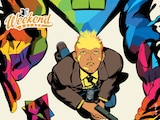At one point in Superman’s long legacy, Krypton became a cautionary tale for Earth. Environmental destruction, political ineffectiveness and cultural conflict have all played a role in its destruction. Classicism has been a part of it as well, but arguably, no comic has offered such an unsparing critique of it as this week’s Absolute Superman, the latest comic in DC’s new universe of titles reimagining some of the world’s most beloved superheroes to better address the challenges of today. This new Man of Steel spent his childhood on Krypton as part of a working class family and witnessed the disdain others had for them firsthand. Now on Earth, he serves as a champion for the planet’s least fortunate, pushing back against the international corporate conglomerates who exploit them.
Recently, we spoke with writer Jason Aaron—whose ongoing DC Black Label series, Batman: Off-World, also challenges our expectations when it comes to its hero—about what happens when Superman grows up witnessing humanity’s cruel and uncaring side.

Batman: Off-World is a story that places Batman in a totally different environment, requiring him to adapt to circumstances that are entirely unfamiliar to him. Was that out-of-the-box approach the same for you in crafting Absolute Superman?
Oh yeah, that times a thousand. With Off-World, I liked the idea of doing something unexpected with a street-level, gritty Batman. Shooting him into space and all that. There’s a lot of my love of DC Comics in that story, taking inspiration from New Teen Titans and Omega Men and all the books I read as a kid and made me a fan. Batman: Off-World represents all that.
Absolute Superman is that turned up to eleven. The first comics I read were issues of World’s Finest and DC Comics Presents. I’ve still got the issue where you clip out a page with five dollars and get sent a chunk of kryptonite, which was a rock spray-painted green. I still have my Superman nightlight. On the one hand, Absolute Superman is about that love and about the character that Siegel and Shuster created in 1938, and who he’s grown to be over the years since that time. The 1978 movie and the comics after Crisis and all of that—all of it gets paid homage. But it also gets interpreted as who might that character be if he were created today. What does his journey look like if he were created not in 1938, but in 2024? The one thing that’s the same is that Krypton explodes. Other than that, assume anything else is different from the story we know. Some of it is profoundly different.
But the journey we’re going on with this character, who he is and what he stands for, it’s the same. If anything, I think we’re doubling down. Everything that we’re doing is a part of showcasing that, but it’s radically different and amped up. This is a guy who’s more alone, more desperate, more angry and more in danger than we’re used to seeing. But at the end of the day, he’s still one thousand percent Superman.

What is it like to change so many key elements while still making the character identifiably Superman? Was that a difficult challenge?
When I first started talking with Scott Snyder about the book, I got really excited. Then I soon felt very nervous, not unlike how I felt writing my issues of Action Comics, putting words in the mouth of Superman for the first time. Making a brand-new version of the character somehow felt bigger.
So, I wrote a huge, massive bible for him, detailing what Krypton was like, what his parents were like, how Kansas fits into the equation and all of it. Once I figured all that out and who this Superman is, everything fell into place. It was about trying to be as bold and daring as we could be, but none of the changes were just for the sake of it. For instance, his costume—there’s a lot that’s different, from the black color to the shape of his cape and his longer hair. None of that was made just to look cool. Every part of that design speaks to his personality. None of it is arbitrary.
All of us are considerate on how to make these stories feel new. For example, you won’t see him hanging out with Batman by issue #3. There will be connections between the other books and how they’re happening at the same time with other characters, but it will be very deliberate.

Speaking of characters, this series offers a surprising spin on Peacemaker. What was the decision to make a version of that character involved in this new Superman story you’re telling?
Trying to be very careful not to spoil, but I will say in issue #1 you get a glimpse of another familiar character. Multiple forces will be against Superman, and some of them will be familiar and some of them won’t be. Peacemaker is not the main bad guy in the story, he’s just part of a larger scope of opposition to our version of Superman.
This new Absolute line of comics recalls other reimagined or updated versions of DC heroes, like Elseworlds and the Earth One line of books. How does Absolute DC compare to what’s come before?
It’s definitely not an Elseworlds. I think of Elseworlds as presenting the same characters we’re familiar with, with some major element that’s profoundly different. Like Superman and Batman in medieval times, or gothic London. That’s the fun of Elseworlds, to explore those options with our favorite characters.
Absolute Superman is completely different in that it’s quite the opposite. In some sense, the heart of Superman, who he is and what he fights for, is the same. If anything, it’s just turned up. It’s everything else around him that’s different. And again, not to just change it but to reimagine it for the story we want to tell. Krypton was a fun example, rethinking what it looks like, what his parents were like, why the planet blew up, what the symbol on Superman’s chest means. It all combines into a picture of who this guy is. To me, all of that made it really exciting to write for, and I think really exciting to read.
Absolute Superman #1 by Jason Aaron, Rafa Sandoval and Ulises Arreola is now available in print and as a digital comic book.

